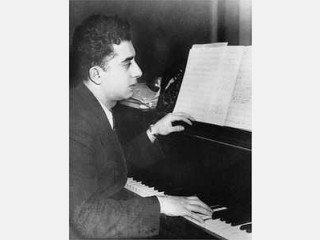
Aram Khachaturian biography
Date of birth : 1903-06-06
Date of death : 1978-05-01
Birthplace : Tiflis, Georgia, Russian Empire
Nationality : Soviet
Category : Famous Figures
Last modified : 2010-12-16
Credited as : Composer, Piano Concerto (1936), the ballet Gayane (1942)
Soviet composer Aram Ilich Khachaturian) is best known for two works: Piano Concerto (1936) and the ballet Gayane (1942), which includes the popular and rhythmic Sabre Dance. His compositions incorporate the folk tunes of his native Armenia and other parts of Russia.
Aram Khachaturian was born on June 6, 1903, in the Armenian community of Tiflis, Georgia, Russian Empire (later part of the U.S.S.R. and now Tbilisi in the Republic of Georgia). Music was not on his mind at the Tiflis Commercial School where he debated between a career in medicine or engineering. In 1920, however, Georgia became part of the new Soviet Union. The following year, Khachaturian, then 17, went to Moscow with his oldest brother, Suren, who was director of the Moscow Art Theater. Like his brother, Khachaturian Russianized name to Khachaturov, which he used for a period of 18 years. Influenced by his brother's work in Moscow, Khachaturian fell under the magic spell of the music world. Although he began to study biology at Moscow University, he took cello lessons as well at the Gnessin Music School.
Khachaturian had hardly mastered the basics of musical composition when he completed his first work, The Dance for violin and piano (1926). By the following year, with the publication of Poem in C Sharp Minor, his extensive use of folk music from his native land was already evident. Said Gerald Abraham in Monthly Musical Record, "The Khachaturian of this period was in the position of an eager, intelligent child who has just been given the run of a toyshop … Like many other young musicians with fuller cultural backgrounds, Khachaturian discovered music through contemporary music, and only later developed a love of the classics."
Over the next several years, Khachaturian studied and also taught at the Moscow Conservatory. Influenced by contemporary Western music, particularly the works of Maurice Ravel, his compositions began to show the maturity, mastery, and rich stirring color that so dominated his music.
The first of Khachaturian's two best-known works, Piano Concerto (1936) was first performed in the United States at the Juilliard Graduate School of Music in New York City on March 15, 1942, followed by the first public performance, by the Boston Symphony Orchestra, that July. Said the music critic of the World-Telegram, "There is no piano concerto in the entire literature to equal this one in sheer energy, speed, and sheer drive…. It happens also to be pretty good music…."
Other works followed, most notably: Happiness, a ballet (1939); Violin Concerto in D Minor (1940), for which he won the Stalin Prize, Second Degree; Second Symphony (1943), written for the 25th anniversary of the Russian revolution; Masquerade (1944), a symphonic suite in the tradition of lavish classical Russian music; and Spartak, a ballet (1953). In addition, he composed violin and cello concerto and numerous minor works.
The second of Khachaturian's best-known works is Sabre Dance from his ballet Gayane (1942). This rhythmically stirring piece has received popular recognition since it was first performed. It is generally played in four-quarter rather than the three-quarter time in which it was written. First performed by the Leningrad Kirov Theatre of the Opera and Ballet, it is set on a collective Soviet farm just before World War II. He received his second Stalin Prize for this piece.
Khachaturian wrote numerous musical works, including marches, dances, chamber music, and film scores. During World War II, he was president of the Moscow Union of Composers and belonged to the Battle Song Staff, which wrote songs for the Russian army.
After the war, however, in 1948, Khachaturian, along with leading composers Sergei Prokofiev and Dmitri Shostakovich, was accused by the Central Committee of the Russian Communist party of having "antidemocratic tendencies" in his music. He was censured by the critics even after he admitted to such charges in public. However, he was restored to favor later that yer when he was praised for his film biography of Lenin. In 1954, he was named People's Artist of the Soviet Union. Five years later, he was awarded the Lenin Prize in recognition of his work. Although the official criticism was later charged to excesses of the Stalin period, it moved Khachaturian closer to Soviet political thinking in the arts. He frequently appered in world forums in the role of champion of an apologist for the Soviet idea of creative orthodoxy. His later works were often criticized as repetitive and eclectic.
Khachaturian's wife, Nina, was also prominent in Soviet cultural life and wrote songs under the name of Nina Makarova. Khachaturian lived in Moscow until his death on May 1, 1978.
Gustav Schneerson, Aram Khachaturian, translated into English by Xenia Denko in 1959, was published by the Moscow Foreign Language Publishing House and reflects Soviet views; Gerald Abraham's, Eight Soviet Composers (1943), includes a chapter on Khachaturian.
















